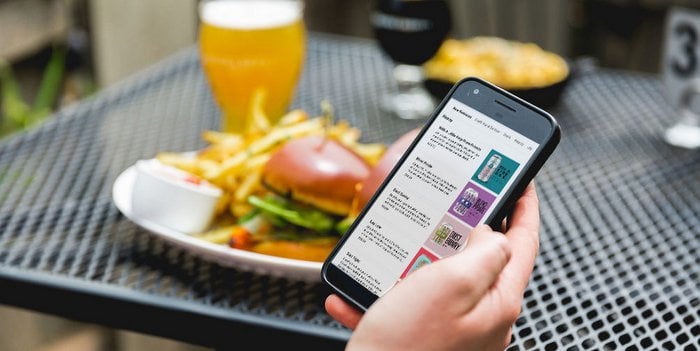
COVID abruptly changed the craft brewery business model by halting on-premise business and causing a mad scramble to add ecommerce and to-go services. Brewery point of sale (POS) vendor Arryved, which has about 15 percent of the taproom segment, was mad scrambling right along with its customers. Arryved does not charge a subscription fee, so its customers’ success is directly tied to customer transactions. As a result, the impact of shutdowns due to the pandemic was visible immediately. Arryved’s team halted everything it was doing and went into a dead sprint to offer an e-commerce service for any customer who wanted one.
“Our support team built 270 sites in the first week and a half ,” Nancy Trigg, president and CGO of Arryved, tells us. “I believe at the highest point, the transaction volume going through those online stores was about 70 percent of sales. In the summer it was around 40, and now online channels are down to less than 10 percent.
That’s still a good chunk of change, but it’s a sign that things are getting back to normal, and just in time for Arryved to roll out its latest very cool on-premise tool: OpenTab, which integrates the ordering and payment experience between customer-owned mobile devices and establishment-owned POS devices. We reached out to Trigg to get more insight into OpenTab, the future of on-premise beer business and how it all might mix with the emergence of eCommerce and self-serve beer tech.
What is the future of that e-commerce service? You launched it in a pinch to meet a huge need. Will it stick around?
Trigg: I think the worlds of e-commerce and on-premise are actually merging. They were looked at as two separate things, and when it comes to the national shipping of alcohol, yes, that’s something else. That’s an entire program that you need to run that needs a lot of love and a lot of compliance. When it comes to the local kind of on-premise and to-go part of your business, they’re starting to merge.
The product that you reached out to us about — the OpenTab feature is the merger of those two. Being able to order from your personal device when you’re sitting in an establishment and also being able to sit at home or in your car and order to-go.
The way that we’ve designed our system, you don’t have to change how you operate. You could turn on your to-go sales if things are slow in the tap room, and turn them off if you’re swamped. It just gives you that ability to kind of pivot back and forth.
I really think the gamechanger is the guest being the owner of the tab versus the counter.
How does OpenTab actually work? As a guest, what am I tangibly doing to order and interact with a brewery?
Right now, you walk into the taproom, you scan a locational QR code for where you are in the taproom, and it opens up an order page. Here you order and enter in your payment information, and then it keeps that tab open, which then syncs with the server’s point of sale. The tab looks like a tab that the server started except it’s got a little icon telling you that it was scanned via a QR code. It also has a little message that says check ID if you haven’t yet.
If the server wants to come up to you and get you another round, they can do that and just add it to that same tab. It gives that total flexibility based on what makes the most sense in the moment.
It can also be fully integrated with to-go sales, which is a different e-commerce system. So, if you’ve only got one person on staff that day, they are able to see both the orders of the people sitting in the taproom and those to-go orders without having to manage two separate systems.
I like that you are differentiating and maximizing the entry points for the consumer, depending on if they are at the brewery or home, but simplifying it all on the back end. … Sticking on the customer point of view, if you’re a loyal customer, are there extra benefits to being in the system? When I come back, will it know it’s me that scanned the QR code and save my information?
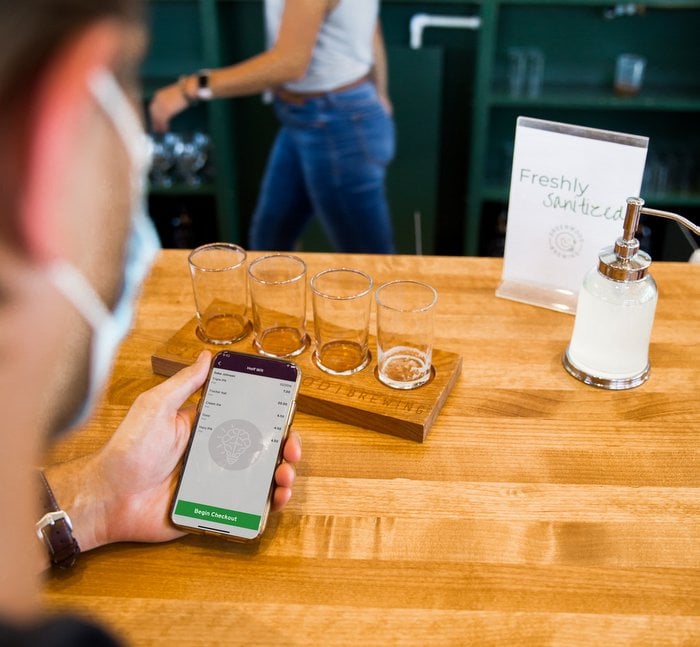
Trigg: We have a loyalty program that is integrated. If you use the same credit card that’s tied to the loyalty program, the system will recognize you and you will start accruing your points, just like you would if you were ordering from a server. That’s true online as well.
The OpenTab experience and the app are two different things because some merchants don’t want OpenTab, but they want the guest to be able to pay from their phone.
So, if I’m in a bad mood or I just want to keep to myself, I can order my beers, and then when I decide it’s time to go, I can just cash out, put my tip on there and just walk out, never waiting to interact with anyone?
Trigg: Correct, that’s a possibility. It’s up to the establishment how much they want to leave in the consumer’s hands.
Everyone’s had this experience where you’re just ready to go and you have to now wait for a server or get back in line to close out your tab. That’s the one that I personally think is the most critical. Just that ability to go when you’re ready to go.
We actually believe that service is hugely valuable, and we’re not here to replace the server because, especially in the craft beverage space, those servers are educators. They’re there to teach you about the products, to make recommendations and to broaden your palate. You don’t want them to be gone. But in a scenario where it’s busy, or you don’t want to interact, no you don’t have to.
You highlight augmenting a staff-led guest experience with supportive technology. So, in your mind what are the time-consuming tasks that we want technology to cut out?
Trigg: When it’s crowded, as a brewery, there’s no way that you can have enough staff to be talking to every person all the time, and sometimes people just want one more real quick. I think that’s a really great place to sort of replace that experience so that you’re not again waiting for that product when you want it, and the brewery doesn’t want to miss those sales experiences.
When you don’t have the staff taking the order, when the staff brings that beverage out — that’s a time to recommend something to try next. They can use that time because they’re not having to run to the next person to get the next order. They can actually take that time to educate and promote that next product that they think is right for that customer.
I fear that sometimes people don’t have time to do anything but transact, and this service experience opens up more time for that conversation with staff that makes the on-premise experience so great.
So, devil’s advocate, why stop there? Because there’s self-serve technology available where you get your bracelet, fill up what you want and come and go as you please. If an owner is looking to drastically save on labor or be ready for slow or busy times, maybe that’s the next step?
Trigg: I think that’s great for a Wendy’s or a gas station, I just don’t think that’s the experience I want when I go out. Right now, we can get anything we want sitting on our couch. So, the reason we go out is because we want an experience, and I don’t want to go out to have to pour my own beer.
We go out for that interactive experience. We go out to learn more about food and beverage, about people. We want to learn the stories of the breweries we’re hanging out in. And I think someone running a brewery that doesn’t see that as missing a big part of why they’re cool.
Do you envision breweries tweaking their staff’s responsibilities, or the way that they approach the role of server now that customers have a little bit more autonomy?
Trigg: In our onboarding we want to make sure they’re taking into consideration how this will impact their staff. Like, if your busiest time is between 11:30 and 1 p.m. at lunch, and you serve food, and your kitchen can only handle so much traffic, you might actually want to pull those QR codes up during lunch so that your kitchen doesn’t get more orders than they can handle.
What can breweries gain from having more data and real-time insights delivered from the POS, and how does OpenTab play into that at all?
Trigg: With OpenTab we can actually track where the dollars originated. So how much did we make through server interactions in the taproom, and how much do we make through this OpenTab feature? How much do we make through online sales? You can get that really granular information about what parts are actually most profitable. What areas of your establishment are most profitable?. We’re tracking your sales to labor cost percentages in real time. So, what are we spending on staff compared to what we are making?
Most point of sales, when you pay, they attribute all the revenue to that moment in time, not the individual items on the tab. With us you can actually see what items sell better at lunch time or dinner. If you now see the shrimp pizza doesn’t sell between 12 and 4, well, don’t make it until four.
Another example: you tell your staff you want them to promote a certain beer that day and to sell tasters of it. You can look at the data in real time and see how many tasters of this product have sold in the last two hours, and then you can react based on the actual findings.
You’ve noted how the system can help reduce waste. How does a POS do that exactly?
Trigg: We do it by making sure you know where your waste is. We do things like track every ounce of every beer that you have sold. If your pints are 15 ounces and not 16, we’re gonna note that in the system as 15 ounces. And if you enter zero dollar tasters that you give away into the POS, we’re tracking that one ounce sold. We have flexibility on comps too, and we encourage our customers who have a comp for spills or bad beer to input it. If you see the same item is getting returned often, well maybe we pull that one off the menu.
Less waste is just about having that real data that you can use to make the right decisions.
Do you think breweries will learn more about their space layout too? Like, man, no one ever sits at this one table. No one’s ever checked in there. Let’s maybe put a couch there instead.
Trigg: We’ve always been able to do that with venues, and we encourage people to look at the venue data to know like does anyone actually sit on the patio after 8 p.m? With the QR codes you’ll know not just what venue they’re in or what area but actually maybe what table. Lots of flexibility there.
What are some other random, nifty, cool things that you’re going to be able to do with OpenTab? Something someone in the service industry is going to really appreciate as part of the tool.
Trigg: The fact that guests can move and cause no confusion. As a guest, you sit down, you scan a QR code at the table, you order a beer, and now you want to go hang out with your friends that are playing cornhole. That whole experience could be a total mess. We built the system so that when you place that next order, it’s going to ask ‘hey are you still where you were five minutes ago?’ You say no and then scan the closest QR code.
We’ve tried to eliminate all of that stress and just make the experience flow.
Another thing we’re empowering, I just got a quote from a partner who’s been using OpenTab for a couple weeks who is excited because it has the potential of increasing tips. That was interesting because when we first started talking about this, there was concern from staff members about the impact on tips. But now he’s starting to see it as a tool that increases tips because you get a more frequent point of service, or maybe it’s just a great experience because it’s less about just getting the order in and more about delivering and engaging.
That ties back to what I said earlier, too. If I sit there and wait to pay for 10 minutes, when I go to hit that tip button it’s probably going to be a little lower right? I don’t have that perception that people weren’t paying attention to me.

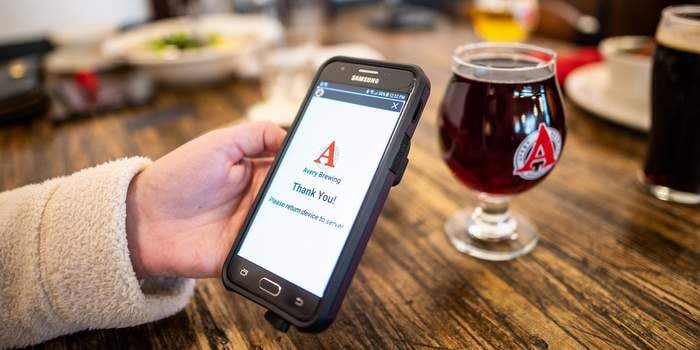
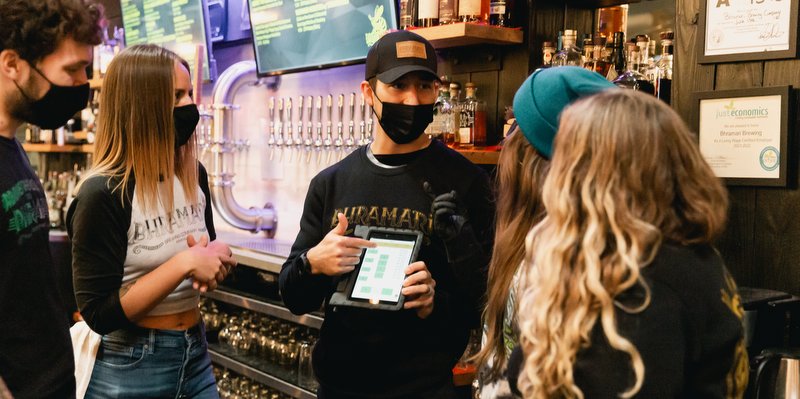
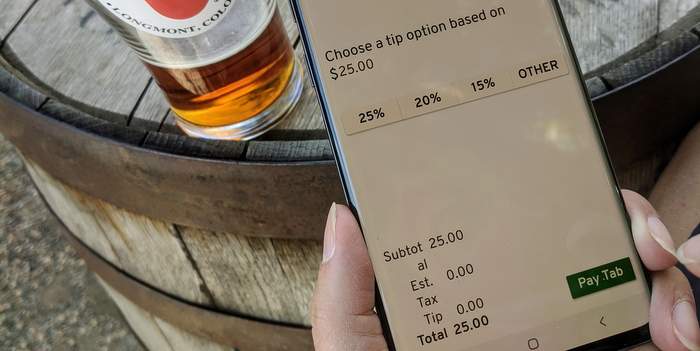
Leave a Reply
You must be logged in to post a comment.